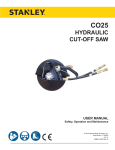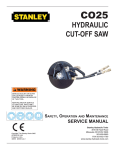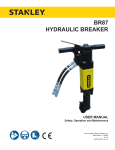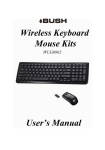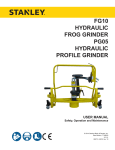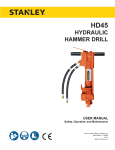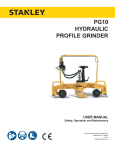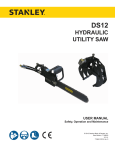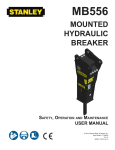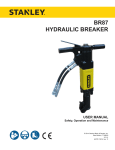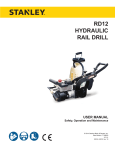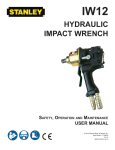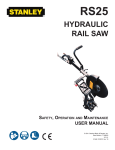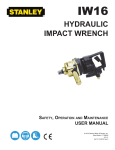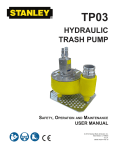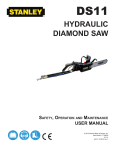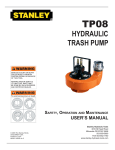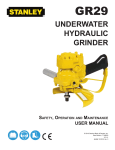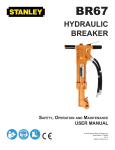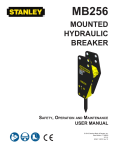Download HYDRAULIC CUT-OFF SAW - Stanley Hydraulic Tools
Transcript
CO25 HYDRAULIC CUT-OFF SAW Safety, Operation and Maintenance USER MANUAL © 2012 Stanley Black & Decker, Inc. New Britain, CT 06053 U.S.A. 34962 11-2013 Ver-12 DECLARATION OF CONFORMITY DECLARATION OF CONFORMITY ÜBEREINSTIMMUNGS-ERKLARUNG DECLARATION DE CONFORMITE CEE DECLARACION DE CONFORMIDAD DICHIARAZIONE DI CONFORMITA Hydraulic Tools ______________________________________________________________________ I, the undersigned: Ich, der Unterzeichnende: Je soussigné: El abajo firmante: lo sottoscritto: Weisbeck, Andy Surname and First names/Familiennname und Vornamen/Nom et prénom/Nombre y apellido/Cognome e nome hereby declare that the equipment specified hereunder: bestätige hiermit, daß erklaren Produkt genannten Werk oder Gerät: déclare que l’équipement visé ci-dessous: Por la presente declaro que el equipo se especifica a continuación: Dichiaro che le apparecchiature specificate di seguito: 1. Category: Kategorie: Catégorie: Categoria: Categoria: Cut-Off-Saw, Hydraulic 2. Make/Marke/Marque/Marca/Marca Stanley 3. Type/Typ/Type/Tipo/Tipo: CO2554101, CO2514101 4. Serial number of equipment: Seriennummer des Geräts: Numéro de série de l’équipement: Numero de serie del equipo: Matricola dell´attrezzatura: All Has been manufactured in conformity with Wurde hergestellt in Übereinstimmung mit Est fabriqué conformément Ha sido fabricado de acuerdo con E’ stata costruita in conformitá con Directive/Standards Richtlinie/Standards Directives/Normes Directriz/Los Normas Direttiva/Norme No. Nr Numéro No n. Approved body Prüfung durch Organisme agréé Aprobado Collaudato ISO ISO Machinery Directive ISO ISO 3744:2010 20643-A1:2012 2006/42/EC:2006 19432:2012 11148-7:2012 Self Self Self Self Self 5. Special Provisions: None Spezielle Bestimmungen: Dispositions particulières: Provisiones especiales: Disposizioni speciali: 6. Representative in the Union: Patrick Vervier, Stanley Dubuis 17-19, rue Jules Berthonneau-BP 3406 41034 Blois Cedex, France. Vertreter in der Union/Représentant dans l’union/Representante en la Union/Rappresentante presso l’Unione Done at/Ort/Fait à/Dado en/Fatto a Stanley Hydraulic Tools, Milwaukie, Oregon USA Signature/Unterschrift/Signature/Firma/Firma Position/Position/Fonction/Cargo/Posizione 2 ► CO25 User Manual Engineering Manager Date/Datum/le/Fecha/Data 8-10-2013 TABLE OF CONTENTS CERTIFICATE OF CONFORMITY....................................................................................................................................................2 SAFETY SYMBOLS..........................................................................................................................................................................4 SAFETY PRECAUTIONS.................................................................................................................................................................5 TOOL STICKERS & TAGS...............................................................................................................................................................7 HYDRAULIC HOSE TYPES.............................................................................................................................................................8 HOSE RECOMMENDATIONS..........................................................................................................................................................9 HTMA / EHTMA REQUIREMENTS.................................................................................................................................................10 OPERATION...................................................................................................................................................................................11 PREOPERATION PROCEDURES.................................................................................................................................................11 CONNECT HOSES.........................................................................................................................................................................11 TOOL OPERATION........................................................................................................................................................................11 STARTUP........................................................................................................................................................................................11 GENERAL OPERATION.................................................................................................................................................................12 WET CUTTING...............................................................................................................................................................................12 BROKEN CUT-OFF WHEELS........................................................................................................................................................12 SHUTDOWN...................................................................................................................................................................................12 PERIODIC MAINTENANCE...........................................................................................................................................................13 THRUST COLLAR AND INSIDE/OUTSIDE COLLAR INSPECTION.............................................................................................13 DRIVE-SHAFT SPEED CHECK.....................................................................................................................................................13 BEARING CHECK..........................................................................................................................................................................13 CARE AND STORAGE...................................................................................................................................................................13 CUTOFF WHEELS.........................................................................................................................................................................13 TOOL..............................................................................................................................................................................................13 CUTOFF WHEEL REPLACEMENT................................................................................................................................................14 COLD WEATHER OPERATION.....................................................................................................................................................14 EQUIPMENT PROTECTION & CARE............................................................................................................................................15 TROUBLESHOOTING....................................................................................................................................................................16 SPECIFICATIONS..........................................................................................................................................................................17 ACCESSORIES..............................................................................................................................................................................17 CO25 PARTS ILLUSTRATION.......................................................................................................................................................18 CO25 PARTS LIST.........................................................................................................................................................................19 IMPORTANT To fill out a Product Warranty Recording form, and for information on your warranty, visit Stanleyhydraulic.com and select the Warranty tab. (NOTE: The warranty recording form must be submitted to validate the warranty). SERVICING: This manual contains safety, operation, and routine maintenance instructions. Stanley Hydraulic Tools recommends that servicing of hydraulic tools, other than routine maintenance, must be performed by an authorized and certified dealer. Please read the following warning. WARNING SERIOUS INJURY OR DEATH COULD RESULT FROM THE IMPROPER REPAIR OR SERVICE OF THIS TOOL. REPAIRS AND / OR SERVICE TO THIS TOOL MUST ONLY BE DONE BY AN AUTHORIZED AND CERTIFIED DEALER. For the nearest authorized and certified dealer, call Stanley Hydraulic Tools at the number listed on the back of this manual and ask for a Customer Service Representative. CO25 User Manual ◄ 3 SAFETY SYMBOLS Safety symbols and signal words, as shown below, are used to emphasize all operator, maintenance and repair actions which, if not strictly followed, could result in a life-threatening situation, bodily injury or damage to equipment. This is the safety alert symbol. It is used to alert you to potential personal injury hazards. Obey all safety messages that follow this symbol to avoid possible injury or death. DANGER This safety alert and signal word indicate an imminently hazardous situation which, if not avoided, will result in death or serious injury. WARNING This safety alert and signal word indicate a potentially hazardous situation which, if not avoided, could result in death or serious injury. CAUTION This safety alert and signal word indicate a potentially hazardous situation which, if not avoided, could result in death or serious injury. CAUTION This signal word indicates a potentially hazardous situation which, if not avoided, may result in property damage. NOTICE This signal word indicates a situation which, if not avoided, will result in damage to the equipment. IMPORTANT This signal word indicates a situation which, if not avoided, may result in damage to the equipment. Always observe safety symbols. They are included for your safety and for the protection of the tool. LOCAL SAFETY REGULATIONS Enter any local safety regulations here. Keep these instructions in an area accessible to the operator and maintenance personnel. 4 ► CO25 User Manual SAFETY PRECAUTIONS Tool operators and maintenance personnel must always comply with the safety precautions given in this manual and on the stickers and tags attached to the tool and hose. These safety precautions are given for your safety. Review them carefully before operating the tool and before performing general maintenance or repairs. Supervising personnel should develop additional precautions relating to the specific work area and local safety regulations. If so, place the added precautions in the space provided on the previous page. The CO25 Hydraulic Cut-Off Saw will provide safe and dependable service if operated in accordance with the instructions given in this manual. Read and understand this manual and any stickers and tags attached to the tool and hose before operation. Failure to do so could result in personal injury or equipment damage. • Do not operate a damaged, improperly adjusted, or incompletely assembled tools. • Never wear loose clothing that can get entangled in the working parts of the tool. • Keep all parts of your body away from the rotating parts. Long hair or loose clothing can become drawn into rotating components. • Always use accessories that conform to the specifications given in this manual. • Release the trigger if the power supply has been interrupted. • When working near electrical conductors, always assume that all conductors are energized and that insulation, clothing and hoses can conduct electricity. Use hose labeled and certified as non-conductive. • To avoid personal injury or equipment damage, all tool repair, maintenance and service must only be performed by authorized and properly trained personnel. • The operator must start in a work area without bystanders. Flying debris can cause serious injury. • Do not operate the tool unless thoroughly trained or under the supervision of an instructor. Establish a training program for all operators to ensure safe operation. • Always wear safety equipment such as goggles, ear, breathing and head protection, and safety shoes at all times when operating the tool. Use gloves and aprons when necessary. Warning: Use of this tool on certain materials during demolition could generate dust potentially containing a variety of hazardous substances such as asbestos, silica or lead. Inhalation of dust containing these or other hazardous substances could result in serious injury, cancer or death. Protect yourself and those around you. Research and understand the materials you are cutting. Follow correct safety procedures and comply with all applicable national, state or provisional health and safety regulations relating to them, including, if appropriate arranging for the safe disposal of the materials by a qualified person. • The operator must be familiar with all prohibited work areas such as excessive slopes and dangerous terrain conditions. • Maintain proper footing and balance at all times. Alway hold the tool with both hands when the unit is running. Use a firm grip. • Do not inspect or clean the tool while the hydraulic power source is connected. Accidental engagement of the tool can cause serious injury. • Always connect hoses to the tool hose couplers before energizing the hydraulic power source. Be sure all hose connections are tight and are in good condition. • Do not operate the tool at oil temperatures above 140°F/60°C. Operation at higher temperatures can cause higher than normal temperatures at the tool which can result in operator discomfort. CO25 User Manual ◄ 5 SAFETY PRECAUTIONS • Never carry the tool or put it down while the wheel is rotating. Make sure it is completely stopped before moving your position or set the tool down. • Do not operate the tool with the wheel guard removed. • Keep the handles dry, clean and free of oil at all times. • Operate the tool in well ventilated areas only. • Do not operate the tool if the wheel does not stop when the trigger is released. • Inspect the wheel guard and collars for damage after any wheel breakage on the tool. • Always use full throttle when cutting. mounted on the saw. • If the cut-off saw is dropped with a cutting wheel installed, thoroughly examine the cutting wheel before use. • Make sure the cutting wheel is correctly mounted and tightened before use. • Operate the cut-off saw at no load for 30 seconds in a safe position. If considerable vibration or other defects are detected, stop operation of the tool immediately and determine the cause. Do not use the tool until the defect is corrected. • Only use cutting wheels that comply with ANSI B7.5/ ISO 525, 603. • Never cock, jam or wedge the wheel during the cut. Do not use the side of the wheel as a cutting surface and be aware of kick-back from the saw. • Check that the maximum operating speed of the cutting wheel is equal to or greater than the rated shaft speed of the cut-off saw. Wheels must be rated at 4700 rpm minimum. • Make sure the tool is designed for the wheel direction suitable for the job. Do not reverse the direction of the wheel rotation by changing the direction of the oil flow. • Warning: Hydraulic fluid under pressure could cause skin injection injury. If you are injured by hydraulic fluid, get medical attention immediately • Always operate the tool within its rated capacity. Never exceed the maximum operating speed marked on the wheel. • Always support and secure items being worked on. • Do not operate the tool near flammable materials, sparks can ignite flammable or combustible materials. • Do not over-reach. • Do not use the tool for applications for which it was not designed. • Keep the wheel off all surfaces when starting the saw. • Do not attempt to adjust the flow control on the valve handle. • Know the location of buried or covered services before starting work. • Adjust the wheel guard so it is between you and the cutting wheel. • Never operate the tool when you are tired. CUT-OFF WHEEL SAFETY • Always inspect the cut-off wheels for possible damage before operating the tool. Do not use a wheel that is cracked or otherwise damaged. • Never transport or store the tool with the cut-off wheel 6 ► CO25 User Manual • Caution when handling the work piece after cutting, object can be hot and have sharp edges, use your personal protection equipment. • Keep your work area clean and clear of tripping hazards, oily surfaces and hoses laying about can be hazardous. • Make sure adequate lighting is always available. • Never operate the tool if you cannot be sure that underground utilities are not present. Underground electrical utilities present an electrocution hazard. Underground gas utilities present an explosion hazard. Other underground utilities may present other hazards. • Do not operate this tool in a potentially explosive environment. Do not grind on vessels containing combustible substances. • Any use of this tool outside those stated in this manual are forbidden. TOOL STICKERS & TAGS D Stanley Hydraulic tools 30 LPM @ 138 B AR EHTMA CATEGORY Division of the Stanley Works 3810 SE Naef Road Milwaukie, OR 97267 11207 CIRCUIT TYPE D DECAL (CE MODELS ONLY) 05152 ADDRESS DECAL 33206 CO25 NAME TAG 28322 CE DECAL (CE MODELS ONLY) Lwa 113 03786 GPM DECAL 28811 INFORMATION PLAQUE 05153 ADDRESS DECAL (CE MODELS ONLY) 52539 SOUND POWER DECAL (CE MODELS ONLY) CAUTION PROTECT YOUR EYES... WEAR SAFETY GOGGLES 28886 COMPOSITE DECAL (CE MODELS ONLY) 1. DO NOT USE DAMAGED WHEELS. 2. USE FULL TROTTLE ONLY WHILE CUTTING. 3. USE ONLY WHEELS MARKED HIGH SPEED REINFORCED THAT MEET REQUIREMENTS OF ANSI B7.1,B7.5 WHEELS SHOULD BE NO LARGER THAN 14" DIA X 5/32" THICK WITH A 1" ARBOR HOLE & RATED FOR 5300 RPM MINIMUM SPEED. 4. INSPECT WHEEL GUARD & COLLARS FOR DAMAGE AFTER ANY WHEEL BREAKAGE ON THE MACHINE. 5. MAXIMUM SPINDLE SPEED IS 5300 RPM. 6. READ OPERATION MANUAL. 05868 SAFETY LABEL NOTE THE INFORMATION LISTED ON THE STICKERS SHOWN, MUST BE LEGIBLE AT ALL TIMES. REPLACE DECALS IF THEY BECOME WORN OR DAMAGED. REPLACEMENTS ARE AVAILABLE FROM YOUR LOCAL STANLEY DISTRIBUTOR. The safety tag (P/N 15875) at right is attached to the tool when shipped from the factory. Read and understand the safety instructions listed on this tag before removal. We suggest you retain this tag and attach it to the tool when not in use. D A N G E R 1. FAILURE TO USE HYDRAULIC HOSE LABELED AND CERTIFIED AS NON-CONDUCTIVE WHEN USING HYDRAULIC TOOLS ON OR NEAR ELECTRICAL LINES MAY RESULT IN DEATH OR SERIOUS INJURY. BEFORE USING HOSE LABELED AND CERTIFIED AS NONCONDUCTIVE ON OR NEAR ELECTRIC LINES BE SURE THE HOSE IS MAINTAINED AS NON-CONDUCTIVE. THE HOSE SHOULD BE REGULARLY TESTED FOR ELECTRIC CURRENT LEAKAGE IN ACCORDANCE WITH YOUR SAFETY DEPARTMENT INSTRUCTIONS. 2. A HYDRAULIC LEAK OR BURST MAY CAUSE OIL INJECTION INTO THE BODY OR CAUSE OTHER SEVERE PERSONAL INJURY. A. DO NOT EXCEED SPECIFIED FLOW AND PRESSURE FOR THIS TOOL. EXCESS FLOW OR PRESSURE MAY CAUSE A LEAK OR BURST. B. DO NOT EXCEED RATED WORKING PRESSURE OF HYDRAULIC HOSE USED WITH THIS TOOL. EXCESS PRESSURE MAY CAUSE A LEAK OR BURST. C. CHECK TOOL HOSE COUPLERS AND CONNECTORS DAILY FOR LEAKS. DO NOT FEEL FOR LEAKS WITH YOUR HANDS. CONTACT WITH A LEAK MAY RESULT IN SEVERE PERSONAL INJURY. D A N G E R D. DO NOT LIFT OR CARRY TOOL BY THE HOSES. DO NOT ABUSE HOSE. DO NOT USE KINKED, TORN OR DAMAGED HOSE. 3. MAKE SURE HYDRAULIC HOSES ARE PROPERLY CONNECTED TO THE TOOL BEFORE PRESSURING SYSTEM. SYSTEM PRESSURE HOSE MUST ALWAYS BE CONNECTED TO TOOL “IN” PORT. SYSTEM RETURN HOSE MUST ALWAYS BE CONNECTED TO TOOL “OUT” PORT. REVERSING CONNECTIONS MAY CAUSE REVERSE TOOL OPERATION WHICH CAN RESULT IN SEVERE PERSONAL INJURY. 4. DO NOT CONNECT OPEN-CENTER TOOLS TO CLOSEDCENTER HYDRAULIC SYSTEMS. THIS MAY RESULT IN LOSS OF OTHER HYDRAULIC FUNCTIONS POWERED BY THE SAME SYSTEM AND/OR SEVERE PERSONAL INJURY. 5. BYSTANDERS MAY BE INJURED IN YOUR WORK AREA. KEEP BYSTANDERS CLEAR OF YOUR WORK AREA. 6. WEAR HEARING, EYE, FOOT, HAND AND HEAD PROTECTION. 7. TO AVOID PERSONAL INJURY OR EQUIPMENT DAMAGE, ALL TOOL REPAIR MAINTENANCE AND SERVICE MUST ONLY BE PERFORMED BY AUTHORIZED AND PROPERLY TRAINED PERSONNEL. I M P O R T A N T I M P O R T A N T READ OPERATION MANUAL AND SAFETY INSTRUCTIONS FOR THIS TOOL BEFORE USING IT. READ OPERATION MANUAL AND SAFETY INSTRUCTIONS FOR THIS TOOL BEFORE USING IT. USE ONLY PARTS AND REPAIR PROCEDURES APPROVED BY STANLEY AND DESCRIBED IN THE OPERATION MANUAL. USE ONLY PARTS AND REPAIR PROCEDURES APPROVED BY STANLEY AND DESCRIBED IN THE OPERATION MANUAL. TAG TO BE REMOVED ONLY BY TOOL OPERATOR. TAG TO BE REMOVED ONLY BY TOOL OPERATOR. SEE OTHER SIDE SEE OTHER SIDE SAFETY TAG P/N 15875 (Shown smaller then actual size) CO25 User Manual ◄ 7 HOSE TYPES The rated working pressure of the hydraulic hose must be equal to or higher than the relief valve setting on the hydraulic system. There are three types of hydraulic hose that meet this requirement and are authorized for use with Stanley Hydraulic Tools. They are: Certified non-conductive — constructed of thermoplastic or synthetic rubber inner tube, synthetic fiber braid reinforcement, and weather resistant thermoplastic or synthetic rubber cover. Hose labeled certified nonconductive is the only hose authorized for use near electrical conductors. Wire-braided (conductive) — constructed of synthetic rubber inner tube, single or double wire braid reinforcement, and weather resistant synthetic rubber cover. This hose is conductive and must never be used near electrical conductors. Fabric-braided (not certified or labeled non-conductive) — constructed of thermoplastic or synthetic rubber inner tube, synthetic fiber braid reinforcement, and weather resistant thermoplastic or synthetic rubber cover. This hose is not certified non-conductive and must never be used near electrical conductors. HOSE SAFETY TAGS To help ensure your safety, the following DANGER tags are attached to all hose purchased from Stanley Hydraulic Tools. DO NOT REMOVE THESE TAGS. If the information on a tag is illegible because of wear or damage, replace the tag immediately. A new tag may be obtained from your Stanley Distributor. D A N G E R D A N G E R 1. FAILURE TO USE HYDRAULIC HOSE LABELED AND CERTIFIED AS NON-CONDUCTIVE WHEN USING HYDRAULIC TOOLS ON OR NEAR ELECTRIC LINES MAY RESULT IN DEATH OR SERIOUS INJURY. FOR PROPER AND SAFE OPERATION MAKE SURE THAT YOU HAVE BEEN PROPERLY TRAINED IN CORRECT PROCEDURES REQUIRED FOR WORK ON OR AROUND ELECTRIC LINES. 2. BEFORE USING HYDRAULIC HOSE LABELED AND CERTIFIED AS NON-CONDUCTIVE ON OR NEAR ELECTRIC LINES. WIPE THE ENTIRE LENGTH OF THE HOSE AND FITTING WITH A CLEAN DRY ABSORBENT CLOTH TO REMOVE DIRT AND MOISTURE AND TEST HOSE FOR MAXIMUM ALLOWABLE CURRENT LEAKAGE IN ACCORDANCE WITH SAFETY DEPARTMENT INSTRUCTIONS. 3. DO NOT EXCEED HOSE WORKING PRESSURE OR ABUSE HOSE. IMPROPER USE OR HANDLING OF HOSE COULD RESULT IN BURST OR OTHER HOSE FAILURE. KEEP HOSE AS FAR AWAY AS POSSIBLE FROM BODY AND DO NOT PERMIT DIRECT CONTACT DURING USE. CONTACT AT THE BURST CAN CAUSE BODILY INJECTION AND SEVERE PERSONAL INJURY. 4. HANDLE AND ROUTE HOSE CAREFULLY TO AVOID KINKING, ABRASION, CUTTING, OR CONTACT WITH HIGH TEMPERATURE SURFACES. DO NOT USE IF KINKED. DO NOT USE HOSE TO PULL OR LIFT TOOLS, POWER UNITS, ETC. 5. CHECK ENTIRE HOSE FOR CUTS CRACKS LEAKS ABRASIONS, BULGES, OR DAMAGE TO COUPLINGS IF ANY OF THESE CONDITIONS EXIST, REPLACE THE HOSE IMMEDIATELY. NEVER USE TAPE OR ANY DEVICE TO ATTEMPT TO MEND THE HOSE. 6. AFTER EACH USE STORE IN A CLEAN DRY AREA. SEE OTHER SIDE SIDE 1 SEE OTHER SIDE (Shown smaller than actual size) DO NOT REMOVE THIS TAG DO NOT REMOVE THIS TAG THE TAG SHOWN BELOW IS ATTACHED TO “CERTIFIED NON-CONDUCTIVE” HOSE SIDE 2 D A N G E R D A N G E R 1. DO NOT USE THIS HYDRAULIC HOSE ON OR NEAR ELECTRIC LINES. THIS HOSE IS NOT LABELED OR CERTIFIED AS NON-CONDUCTIVE. USING THIS HOSE ON OR NEAR ELECTRICAL LINES MAY RESULT IN DEATH OR SERIOUS INJURY. 5. CHECK ENTIRE HOSE FOR CUTS CRACKS LEAKS ABRASIONS, BULGES, OR DAMAGE TO COUPLINGS IF ANY OF THESE CONDITIONS EXIST, REPLACE THE HOSE IMMEDIATELY. NEVER USE TAPE OR ANY DEVICE TO ATTEMPT TO MEND THE HOSE. 2. FOR PROPER AND SAFE OPERATION MAKE SURE THAT YOU HAVE BEEN PROPERLY TRAINED IN CORRECT PROCEDURES REQUIRED FOR WORK ON OR AROUND ELECTRIC LINES. 6. AFTER EACH USE STORE IN A CLEAN DRY AREA. 3. DO NOT EXCEED HOSE WORKING PRESSURE OR ABUSE HOSE. IMPROPER USE OR HANDLING OF HOSE COULD RESULT IN BURST OR OTHER HOSE FAILURE. KEEP HOSE AS FAR AWAY AS POSSIBLE FROM BODY AND DO NOT PERMIT DIRECT CONTACT DURING USE. CONTACT AT THE BURST CAN CAUSE BODILY INJECTION AND SEVERE PERSONAL INJURY. 4. HANDLE AND ROUTE HOSE CAREFULLY TO AVOID KINKING, CUTTING, OR CONTACT WITH HIGH TEMPERATURE SURFACES. DO NOT USE IF KINKED. DO NOT USE HOSE TO PULL OR LIFT TOOLS, POWER UNITS, ETC. SEE OTHER SIDE SEE OTHER SIDE SIDE 1 SIDE 2 (Shown smaller than actual size) 8 ► CO25 User Manual DO NOT REMOVE THIS TAG DO NOT REMOVE THIS TAG THE TAG SHOWN BELOW IS ATTACHED TO “CONDUCTIVE” HOSE. All hydraulic hose must meet or exceed specifications as set forth by SAE J517. All hydraulic hose must have at least a rated minimum working pressure equal to the maximum hydraulic system relief valve setting. This chart is intended to be used for hydraulic tool applications only based on Stanley Hydraulic Tools tool operating requirements and should not be used for any other applications. The chart to the right shows recommended minimum hose diameters for various hose lengths based on gallons per minute (gpm)/ liters per minute (lpm). These recommendations are intended to keep return line pressure (back pressure) to a minimum acceptable level to ensure maximum tool performance. Tool to Hydraulic Circuit Hose Recommendations 15-34 MM Inside Diameter INCH USE (Press/Return) PSI up to 10 up to 3 3/8 10 Both 2250 49-60 13-16 FLOW >>> RETURN <<< FLOW PRESSURE 26-100 up to 25 100-200 51-100 up to 50 100-300 51-100 up to 50 26-100 up to 25 8-30 up to 8 30-60 15-30 up to 15 30-90 15-30 up to 15 7.5-30 up to 7.5 Figure 1. Typical Hose Connections 49-60 38-49 10-13 13-16 19-40 5-10.5 38-49 19-40 5-10.5 10-13 19-40 5-10.5 38-49 15-23 10-13 15-23 4-6 19 25.4 16 19 19 25.4 5/8 3/4 3/4 1 19 3/4 1 16 3/4 16 19 3/4 5/8 16 5/8 5/8 16 13 13 10 5/8 1/2 1/2 3/8 Return Pressure Return Pressure Return Pressure Return Pressure Both Return Pressure Both Both Both Both 2500 2500 2500 2500 2500 2500 2500 2500 2500 2500 2500 2500 2500 2500 2500 175 175 175 175 175 175 175 175 175 175 175 175 175 175 175 155 BAR Min. Working Pressure Certified Non-Conductive Hose - Fiber Braid - for Utility Bucket Trucks METERS Hose Lengths FEET Conductive Hose - Wire Braid or Fiber Braid -DO NOT USE NEAR ELECTRICAL CONDUCTORS 4-6 4-9 LPM Oil Flow GPM HOSE RECOMMENDATIONS CO25 User Manual ◄ 9 HTMA / EHTMA REQUIREMENTS HTMA / EHTMA REQUIREMENTS HTMA HYDRAULIC SYSTEM REQUIREMENTS TYPE I Nominal Operating Pressure (at the power supply outlet) 4-6 gpm (15-23 lpm) 1500 psi (103 bar) TOOL TYPE TYPE II TYPE RR 7-9 gpm (26-34 lpm) 1500 psi (103 bar) 9-10.5 gpm (34-40 lpm) 1500 psi (103 bar) System relief valve setting (at the power supply outlet) 2100-2250 psi (145-155 bar) 2100-2250 psi (145-155 bar) 2200-2300 psi (152-159 bar) 2100-2250 psi (145-155 bar) Maximum back pressure (at tool end of the return hose) 250 psi (17 bar) 250 psi (17 bar) 250 psi (17 bar) 250 psi (17 bar) Measured at a max. fluid viscosity of: (at min. operating temperature) 400 ssu* 400 ssu* 400 ssu* 400 ssu* (82 centistokes) (82 centistokes) (82 centistokes) (82 centistokes) Temperature: Sufficient heat rejection capacity to limit max. fluid temperature to: (at max. expected ambient temperature) 140° F (60° C) Flow Range 140° F (60° C) 140° F (60° C) TYPE III 11-13 gpm (42-49 lpm) 1500 psi (103 bar) 140° F (60° C) 3 hp 5 hp 6 hp 7 hp Min. cooling capacity at a temperature (2.24 kW) (3.73 kW) (5.22 kW) (4.47 kW) difference of between ambient and fluid 40° F 40° F 40° F 40° F temps (22° C) (22° C) (22° C) (22° C) NOTE: Do not operate the tool at oil temperatures above 140° F (60° C). Operation at higher temperatures can cause operator discomfort at the tool. Filter Min. full-flow filtration Sized for flow of at least: (For cold temp. startup and max. dirt-holding capacity) 25 microns 30 gpm (114 lpm) Hydraulic fluid Petroleum based (premium grade, anti-wear, non-conductive) Viscosity (at min. and max. operating temps) 100-400 ssu* 25 microns 30 gpm (114 lpm) 25 microns 30 gpm (114 lpm) 100-400 ssu* 100-400 ssu* (20-82 centistokes) 25 microns 30 gpm (114 lpm) 100-400 ssu* NOTE: When choosing hydraulic fluid, the expected oil temperature extremes that will be experienced in service determine the most suitable temperature viscosity characteristics. Hydraulic fluids with a viscosity index over 140 will meet the requirements over a wide range of operating temperatures. *SSU = Saybolt Seconds Universal EHTMA HYDRAULIC SYSTEM REQUIREMENTS CLASSIFICATION B C D Nominal Operating Pressure (at the power supply outlet) 3.5-4.3 gpm (13.5-16.5 lpm) 1870 psi (129 bar) 4.7-5.8 gpm (18-22 lpm) 1500 psi (103 bar) 7.1-8.7 gpm (27-33 lpm) 1500 psi (103 bar) 9.5-11.6 gpm (36-44 lpm) 1500 psi (103 bar) 11.8-14.5 gpm (45-55 lpm) 1500 psi (103 bar) System relief valve setting (at the power supply outlet) 2495 psi (172 bar) 2000 psi (138 bar) 2000 psi (138 bar) 2000 psi (138 bar) 2000 psi (138 bar) Flow Range NOTE: These are general hydraulic system requirements. See tool specification page for tool specific requirements 10 ► CO25 User Manual OPERATION PREOPERATION PROCEDURES CHECK THE POWER SOURCE 3. Check that the safety catch on the handle assembly is operating properly. It should prevent engagement of the trigger unless the catch is pressed down fully in the handle slot. Careful inspection of the tool and hydraulic system before startup is important for safe, reliable operation of the tool. CONNECT HOSES 1. Using a calibrated flowmeter and pressure gauge, check that the hydraulic power source develops a flow of 7–9 gpm (26–34 lpm) at 2000 psi (140 bar). 1. Wipe all hose couplers with a clean, lint-free cloth before making connections. 2. Make certain the hydraulic power source is equipped with a relief valve set to open at 2100–2250 psi (145–155 bar). 2. Connect hoses from the hydraulic power source to the tool fittings or quick disconnects. It is good practice to connect the return hose first and disconnect it last to minimize or eliminate trapped pressure within the wrench. CHECK THE TOOL The following items should be checked daily. Make sure the hydraulic system control valve is in the “OFF” position and the hoses are disconnected before inspecting the cutoff saw. 1. Inspect the cut-off wheel and guard. Make sure the correct cut-off wheel is installed for the job. If not, follow the instructions for Cut-off Wheel Replacement section of this manual. 2. Inspect the wheel for chips, cracks, or other damage. For maximum tool performance, replace the wheel if it is worn or defective. 3. Inspect the wheel guard for cracks or other structural damage. 3. Observe the flow indicators stamped on the valve handle assembly and the hose couplers to ensure that the flow is in the proper directions. The female couple on the tools “IN” port is the inlet (pressure) coupler. Note: If the uncoupled hoses are left in the sun, pressure increase within the hoses can make them difficult to connect. Whenever possible, connect the free ends of hoses together. TOOL OPERATION STARTUP 1. Move the hydraulic system control valve to the “ON” position. 4. There should be no signs of leaks. 2. At the beginning of each shift, or after a new wheel is installed, run the cut-off saw at operating speed for at least one minute before starting work. 5. Inspect the handlebar. Make sure the handlebar is securely fastened to the cutoff saw and is clean of any oil to ensure a firm grip. HANDHELD CONFIGURATION: IMPORTANT Check the speed of the motor output shaft after every 100 hours of operation. CHECK TRIGGER MECHANISM 1. Inspect the trigger and safety catch. Make sure the trigger operates smoothly and is free to travel between the “ON: and “OFF” positions. 2. Make sure the trigger is set to disengage the cut-off saw when released. 1.Press the safety catch into the handle, then slowly squeeze the trigger. 2. Run the saw at least one minute. 3. Release the trigger and safety catch. MOUNTED CONFIGURATION (SAW CART): 1. Make sure the lower edge of the cutoff wheel is at least 1 inch above the work surface. 2. Slowly squeeze the hand control lever. 3. Run the saw at least one minute, then release the control lever. CO25 User Manual ◄ 11 OPERATION If excessive vibration or any other defect is detected, stop the tool immediately and determine the cause. Do not use the tool until the problem is corrected. GENERAL OPERATION HANDHELD CONFIGURATION: 1. Whenever possible, clamp or hold down the work and support it securely on both sides of the cut. 2. Press the safety catch into the handle, then slowly squeeze the trigger. 3. Start the cut with the wheel rotating. Start the work gently with consistent pressure. Do not bump the saw into the workpiece. 4. Feed the wheel through the material as fast as possible without slowing the wheel rotation speed. Cutting through the material too slowly causes heat expansion and can result in wheel “pinching” in the material. This is one of the most common causes or wheel breakage. MOUNTED CONFIGURATION (SAW CART): When the cutoff saw is mounted on a saw cart, always use a motor-type hydraulic system control valve to turn the saw “ON” and “OFF”. All ports must be connected to the tank (hydraulic system reservoir) when the control valve is in neutral. Alternatively, use a direct line from the tool outlet to the tank. IMPORTANT Keep all four wheels of the cart on the cutting surface at all times. Do not tip the front of the cart up during operation or while the blade is in motion. 1. Align the cut line indicator on the line to be cut. 2. Lower the blade to approximately 1/2 to 1-inch above the cutting surface. Set the depth gauge to ensure accurate cutting depth. 3. Make sure the water hose and its connections are secure and there is a steady flow of coolant water. 4. Slowly squeeze the hand control lever. 5. Slowly and safely lower the rotating blade into the cutting surface to the desired depth: Increase the depth by turning the depth-control crank counterclockwise (CCW). 12 ► CO25 User Manual Periodically look at the depth gauge and pointer to check the actual depth of the cutting blade. 6. Move slowly and safely forward along the cutting line until the desired cut is complete. The safe forward rate depends on your blade type. 7. Release the hand control lever. 8. To raise the blade from of the cutting surface, wait until the blade comes to a complete stop in the work material. Turn the depth-control crank clockwise (CW) until the blade clears the surface. WET CUTTING 1. Make sure the cutting wheel is suitable for wet cutting. 2. When shutting down a wet-cutting operation: a. Stop the tool. b. Shut off the water. Restart the tool and allow the wheel to spin off the excess water. BROKEN CUT-OFF WHEELS Cut-off wheels designed for use with portable saws are extremely tough. When used as directed, they are difficult to break during normal use. If a wheel breaks while operating the cut-off saw, investigate the cause of the failure and correct the problem as soon as possible. If you cannot determine the cause of failure, contact the wheel manufacturer. SHUTDOWN 1. Move the hydraulic system control valve to the “OFF” position. 2. Disconnect the hydraulic hoses from the tool (first the input (supply) hose, then the output (return) hose). 3. Place dust plugs in the hose ends, couplers or tool ports, as applicable. 4. Wipe the tool thoroughly with a clean dry cloth. 5. Clean any foreign matter from the cut-off wheel surfaces. OPERATION PERIODIC MAINTENANCE CARE AND STORAGE For maximum performance and reliability of the tool, periodically check the following components. Remove the cutoff wheel from the tool after use. Do not store or transport the saw with the wheel installed. Clean and inspect the wheel and tool before storing. THRUST COLLAR AND INSIDE/OUTSIDE COLLAR INSPECTION CUTOFF WHEELS Periodically inspect the thrust collar for damage when you remove the cut-off wheel (refer to Cutoff Wheel Replacement). 1. Remove the key and thrust collar from the motor shaft. 2. Check the thrust collar for burrs. Remove burrs as required. 3. Check the threads on the clamping setscrew. 4. Inspect the collar bores and flanges. 5. Check for burrs. Remove burrs as required. 6. Check that the bearing surfaces are flat and run true when mounted on the motor shaft and thrust collar. All abrasive cutoff wheels are breakable. Exercise care in handling and storage to prevent damage. 1. Clean used wheels to remove any dirt, debris, or grease. Dry thoroughly. 2. Inspect the wheel for chips, cracks, or other damage. For maximum tool performance, replace the wheel if it is worn or defective. 3. Store cutoff wheels on a flat surface of steel or similar rigid material. 4. If wheels are supplied with blotters attached, insert suitable separators between each wheel and the supporting surface to preserve flatness. DRIVE-SHAFT SPEED CHECK 5. Do not store wheels where they will be exposed to high humidity, water or other liquids, excessive heat, or freezing temperatures. Check the speed of the motor output shaft at least every 100 hours of operation. The test should be performed only by a trained, experienced technician. 6. Avoid temperatures low enough to cause condensation on the wheels if they are moved from storage to an area of higher temperature. • Maintain a record of the speed checks. 7. Wheels carried on emergency vehicles should be removed after use, and discarded or stored carefully (steps 1 and 2). • The maximum rated speed of the CO25 Hydraulic Cutoff Saw is 4500 rpm. • The rated speed of the cutting wheel must be equal to, or greater than that of the tool to ensure the integrity of the wheel at maximum tool speed. • Use the hydraulic power supply normally used with the cutoff saw when conducting this test. • Excessive speed may be caused by excessive hydraulic fluid flow to the tool. BEARING CHECK TOOL 1. Clean the tool to remove any dirt, debris, or grease. Dry with compressed air or clean dry cloths. 2. Replace any damaged or missing safety labels and tags before storing the tool. Otherwise, the tool might be improperly used by someone who is not familiar with the safety requirements. 3. Store the tool in a clean, dry place. Periodically inspect the bearings and associated parts for proper operation. A worn or damaged bearing can cause motor damage. CO25 User Manual ◄ 13 OPERATION CUTOFF WHEEL REPLACEMENT 1. Move the hydraulic system control valve to the Off position. 2. Disconnect the hydraulic hoses from the tool (first the input (supply) hose, then the output (return) hose). 3. Install the inside collar and blotter, rotate the collar to align the slot in the collar with the pin on the thrust collar. 4. The maximum rated speed of the hydraulic cutoff saw is 4500 rpm. Never install a cutoff wheel that is not rated equal to or greater than that of the tool to ensure the integrity of the wheel at the maximum tool speed. 5. Prior to installing the wheel, inspect it for chips, cracks or other damage and replace if damaged. 6. Install the outside blotter and collar, rotate the collar so that the flat on the motor shaft aligns with the flat on the outside collar. 7. Install the wheel nut using a wrench while gripping the cutoff wheel. Tighten securely. COLD WEATHER OPERATION Before using the tool in cold weather, preheat the hydraulic fluid with the power unit operating at a low speed. The oil should be at or above 50°F (10°C) with a viscosity of 400 SSU (82 cs) before operating the tool. 14 ► CO25 User Manual TOOL PROTECTION & CARE NOTICE In addition to the Safety Precautions found in this manual, observe the following for equipment protection and care. • Make sure all couplers are wiped clean before connection. • The hydraulic circuit control valve must be in the “OFF” position when coupling or uncoupling hydraulic tools. Failure to do so may result in damage to the quick couplers and cause overheating of the hydraulic system. • Always store the tool in a clean dry space, safe from damage or pilferage. • Make sure the circuit PRESSURE hose (with male quick disconnect) is connected to the “IN” port. The circuit RETURN hose (with female quick disconnect) is connected to the opposite port. Do not reverse circuit flow. This can cause damage to internal seals. • Always replace hoses, couplings and other parts with replacement parts recommended by Stanley Hydraulic Tools. Supply hoses must have a minimum working pressure rating of 2500 psi/172 bar. • Do not exceed the rated flow (see Specifications) in this manual for correct flow rate and model number. Personal Injury and rapid failure of the internal seals may result. • Always keep critical tool markings, such as warning stickers and tags legible. • Tool repair should be performed by experienced personnel only. • Make certain that the recommended relief valves are installed in the pressure side of the system. • Do not use the tool for applications for which it was not intended. CO25 User Manual ◄ 15 TROUBLESHOOTING If symptoms of poor performance develop, the following chart can be used as a guide to correct the problem. When diagnosing faults in operation of the wrench, always check that the hydraulic power source is supplying the correct hydraulic flow and pressure to the tool as listed in the following table. Use a flow meter known to be accurate. Check the flow with the hydraulic fluid temperature at least 80o F/27o C. PROBLEM Tool does not operate. Tool operates in reverse. Oil leakage between motor housing and ON/OFF vlave block or motor. Trigger difficult to operate. Saw cuts too slowly. 16 ► CO25 User Manual CAUSE SOLUTION Hydraulic ontrol valve OFF. Turn the hydraulic system control valve ON. Hydraulic hoses not connected properly. Make sure the hoses are connected and the couplers are tight. Hydraulic system not functioning. Check power unit for correct flow and presssure. Couplers or hoses blocked. Remove obstruction. Mechanical failure. Disassemble tool and inspect for damage. Hoses connected to wrong ports on tool. Connect input (supply) line to IN port and connect output (return) line to OUT port. Oil tube o-ring failure. Replace o-ring. Motor face seal failure. Replace seal. Hoses connected to wrong ports on tool. Connect input (supply) line to IN port and connect output (return) line to OUT port. Excessive back-pressure. If back pressure is greater than 250 psi/17 bar, correct the return line obstruction or restriction. Wrong cut-off wheel for work material. Use correct wheel. Insufficient oil flow. Adjust oil flow to 7-9 gpm/26-34 lpm. Relief valve setting too low. Adjust relief valve to 2100-2250 psi/145-155 bar. SPECIFICATIONS Wheel Capacity..............................................................................................................................................14-inch/15.6 cm Weight.................................................................................................................................................................... 20 lbs/9 kg Overall Length...................................................................................................................................................21-inch/53 cm Width................................................................................................................................................................. 11-inch/28 cm Pressure Range........................................................................................................................... 1500-2000 psi/105-140 bar Flow Range............................................................................................................................................... 7-9 gpm/26-34 lpm Optimum Flow....................................................................................................................................................8 gpm/30 lpm System Type................................................................................................................................ Open Center, HTMA Type II Porting...............................................................................................................................................................8 SAE O-Ring Connect Size and Type................................................................................................................ 3/8-inch Male Pipe Adapter Max Spindle Speed.................................................................................................................................................. 4700 rpm ACCESSORIES DESCRIPTION PART NUMBER 14-inch Abrasive Wheel for Metal, 1-inch Arbor............................................................................................................ 02691 14-inch Abrasive Wheel for Masonry, 1-inch Arbor........................................................................................................ 02692 Diamond Blade, 14-inch Dry Cut................................................................................................................................... 62358 Water Attachment Kit for CO25 (Includes (1) Water Hose Assy P/N-33220, (1) 9.125-inch Long Tube P/N-33226, (1)7.812-inch Long Tube P/N-33227, (1) Brass Adaptor P/N-35196, (3) Male 90Deg Elbow 1/4” hose barb P/N-33223, (1) Male Elbow Brass P/N-35197....................................................................................................................................... 33228 Slab Saw Cart............................................................................................................................................................... 69290 Water Tank Kit for Slab Saw Cart (Includes (1) Tank Top Bracket P/N-69296, (1) Tank Bracket P/N-69542, (1) Water tank P/N-41240, (1) Needle Valve Clamp P/N-69914, (2) Capscrews P/N-32412, (9) Capscrews P/N-15476, and (11) Nuts P/N00719............................................................................................................................................................................ 69704 Handle Extension Kit (Includes- (2) Oil Tubes P/N-31945, (1) Handle Weldment P/N-34116, (1) Extension P/N-34172, (4) O-Rings P/N-00175, Hardware- (2) Lockwashers P/N-01459, (2) 3/8” Capscrews P/N-02116, (4) 5/16” Capscrews P/N10888 and Inst Sheet ................................................................................................................................................... 34175 SOUND POWER AND VIBRATION DECLARATION Test conducted on CO25541, S/N 673 operated at standard 12 gpm input..................................................................................... Measured A-weighted sound power level, Lwa (ref. 1pW) in decibels............................................................................ 109.4 dBA Uncertainty, Kwa, in decibels.................................................................................................................................................. 3 dBA Measured A-weighted sound pressure level, Lpa (ref. 20 µPa) at operator's position, in decibels................................. 101.5 dBA Uncertainty, Kpa, in decibels.................................................................................................................................................. 3 dBA Values determined according to noise test code given in ISO 15744, using the basic standard ISO3744 NOTEThe sum of a measured noise emision value and its associated uncertainty represents an upper boundry of the range of values which is likely to occur in measurements......................................................................................................................................... Declared vibration emission value in accordance with EN 12096.................................................................................................... Measured vibration emmission value: a.......................................................................................................................... 4.9 m/sec² Uncertainty: K................................................................................................................................................................ 0.14 m/sec² Values determined according to ISO 19432:2012, ISO 5349-1,2..................................................................................................... CO25 User Manual ◄ 17 For Parts to Handle Extension Kit, See Accessories on Page 17 PARTS ILLUSTRATION 18 ► CO25 User Manual PARTS LIST Item No. Part No. Qty Description Item No. Part No. Qty Description 1 01714 1 Jam Nut, CCW 42 03048 1 Lever 03012 1 Jame Nut, CW 43 01594 2 Washer 2 31028 1 Outer Collar 44 03047 1 Roll Pin 3 04876 1 Inside Collar 45 05071 2 Capscrew 4 00720 1 Set Screw 46 32445 1 Guard Clamp 5 04673 1 Thrust Collar 47 03025 1 Bolt 6 03013 1 Retaining Ring 48 32436 1 Wheel Guard 7 00563 1 Roll Pin 33084 1 Motor Assy, CCW (Incl Items 49-57, 59-66) 8 05152 1 Stanley Sticker (USA Models Only) 33083 1 Motor Assy, CW (Incl Items 49-57, 59-66) 9 05868 1 Caution Sticker (USA Models Only) 32047 1 Motor Shaft (CCW Models Only) 10 01420 1 Helicoil 32872 1 Motor Shaft (CW Models Only) 11 20460 1 Handle Strut 50 00170 1 Retaining Ring 12 03006 2 Capscrew 51 30333 1 Seal Gland 13 02688 8 Capscrew 52 350771 1 O-ring • 14 02649 2 Handle Bar Retainer 53 00214 1 Quad Ring • 15 00175 4 O-ring • 54 00120 8 Capscrew 16 02912 2 Oil Tube 55 31849 1 Gear Hsg Assy 17 17681 1 Spring Pin 56 06316 4 Bushing 18 32026 1 Valve Spool (CCW Models Only) 57 06881 2 Needle Roller 31138 1 Valve Spool (CW Models Only) 58 00772 1 Key 19 01604 2 O-ring • 59 00148 1 Bearing 20 02931 1 Valve Cap 60 00166 1 Retaining Ring 21 00112 1 Quad Ring • 61 30591 1 Bearing Hsg Assy 22 01219 1 Pipe Plug 62 00713 2 Dowel Pin 23 31854 1 Flow Control 63 00178 1 O-ring • 24 35963 1 Capscrew 64 73309 1 Idler Shaft 25 02920 1 Spacer 65 06853 2 Driver Gear 26 22707 1 Trigger 67 33206 1 Name Tag 27 22704 1 Safety Catch 68 28322 1 CE Sticker (CE Models Only) 28 22701 1 Torsion Spring 69 28886 1 Composite Sticker (CE Models Only) 29 28552 1 Valve Handle Assy (Incld Item 22) 70 28811 1 Information Plaque (CE Models Only) 30 07226 2 Hose Assy (Incld Item 34) 71 05153 1 Stanley Sticker (CE Models Only) 31 03009 1 Roll Pin 72 02004 2 Drive Screw 32 02911 1 Hose Clip 73 52539 1 Sound Power Level Decal 33 03786 1 Caution Sticker (USA Models Only) 24058 1 Coupler, Female (Not Shown) 11207 1 Circuit D Sticker (CE Models Only) 24059 1 Coupler, Male (Not Shown) 34 01605 2 O-ring • (Incld with Item 30) 24069 1 Coupler Set 35 31186 1 Poppet 36 02916 1 Compression Spring 31845 1 SEAL KIT 37 ——- - NO ITEM 38 31137 1 Plug 39 02654 1 Handle Bar 40 02950 1 Motor Housing 41 03049 1 Swing Over Nut 49 • Denotes Part in Seal Kit 33084 - Motor Assy, CCW Rotation (Incl Items 49-57, 59-66) 33083 - Motor Assy, CW Rotation (Incl Items 49-57, 59-66) CO25 User Manual ◄ 19 Stanley Hydraulic Tools 3810 SE Naef Road Milwaukie, Oregon 97267-5698 USA (503) 659-5660 / Fax (503) 652-1780 www.stanleyhydraulic.com




















